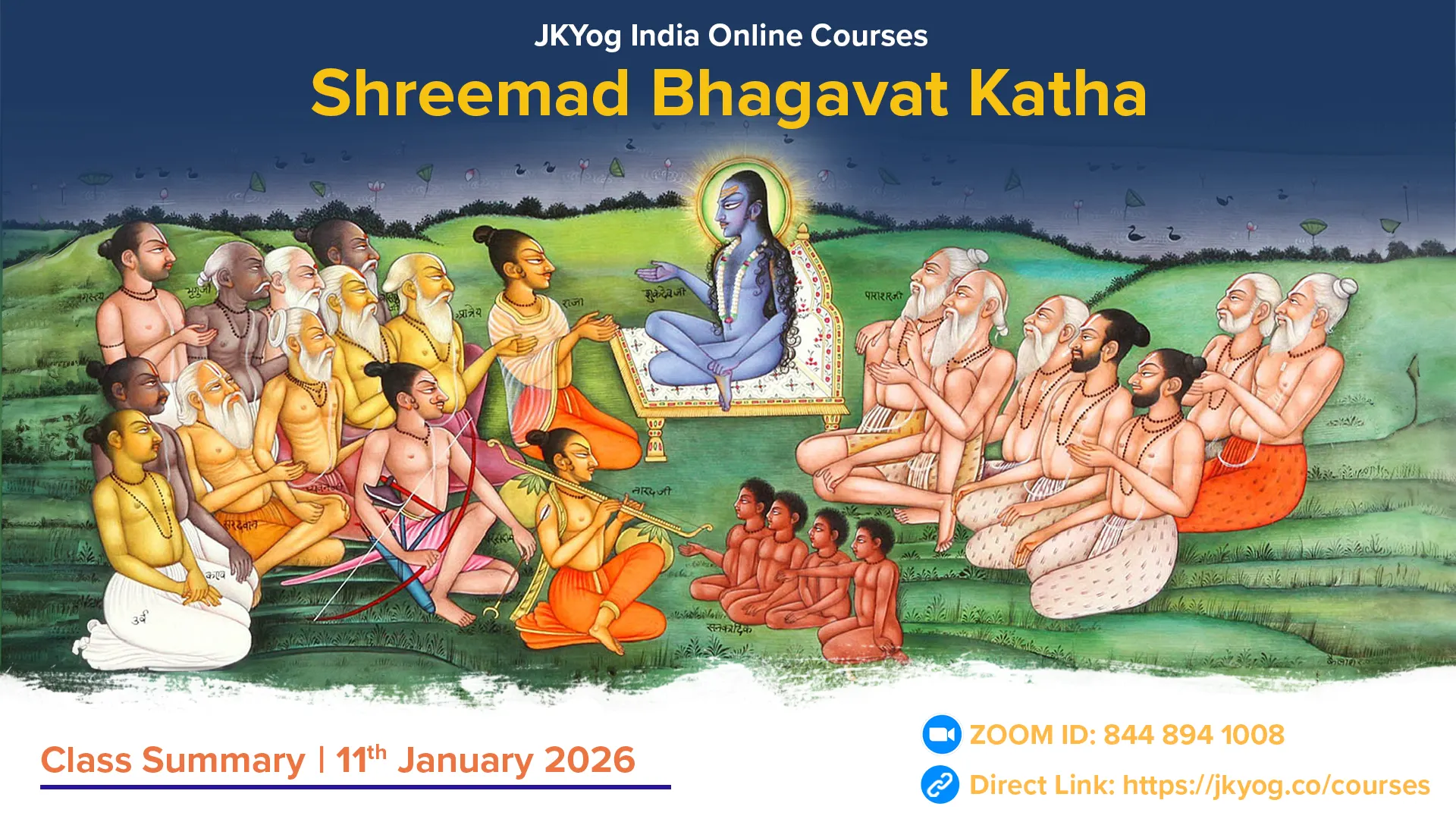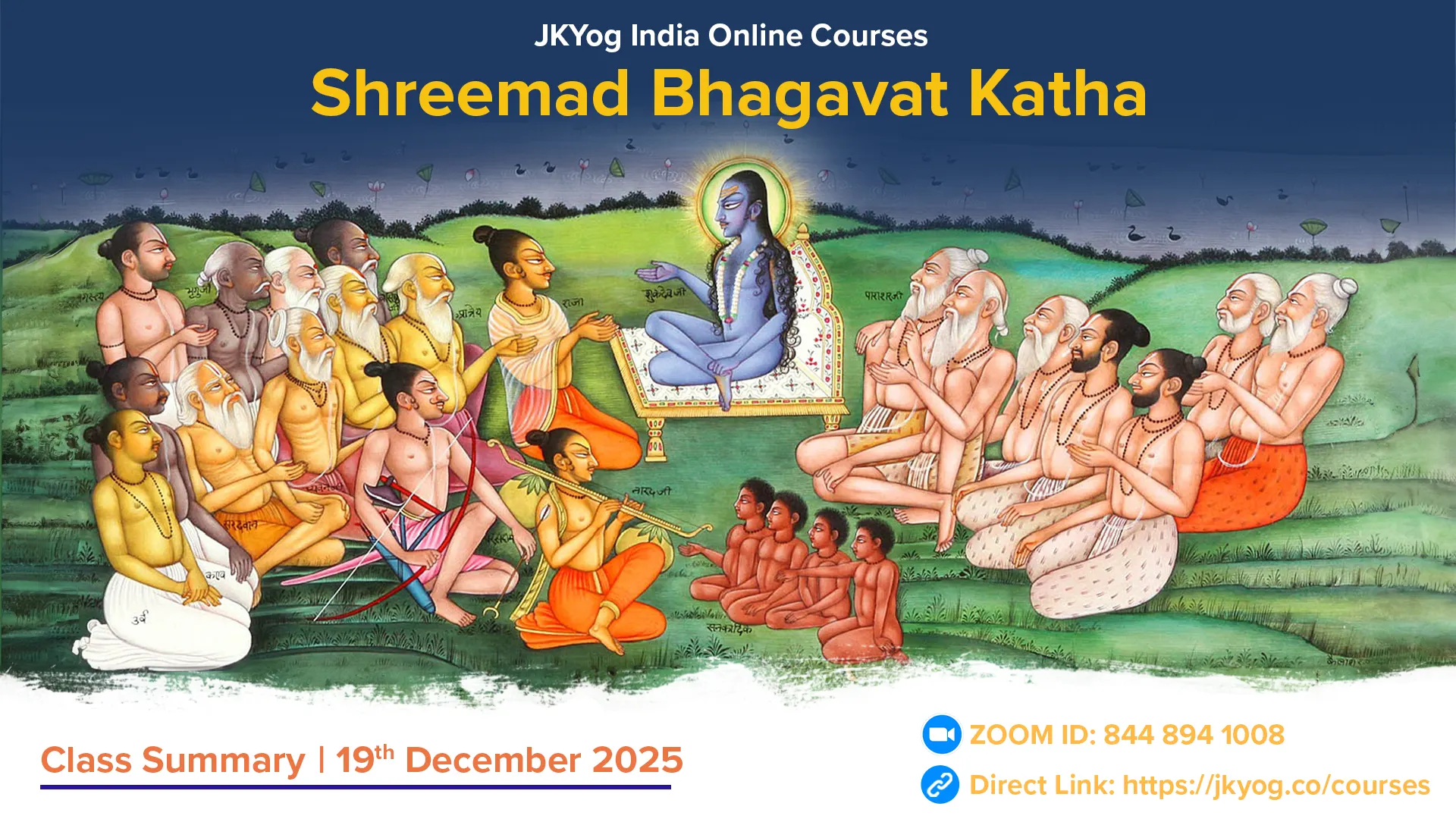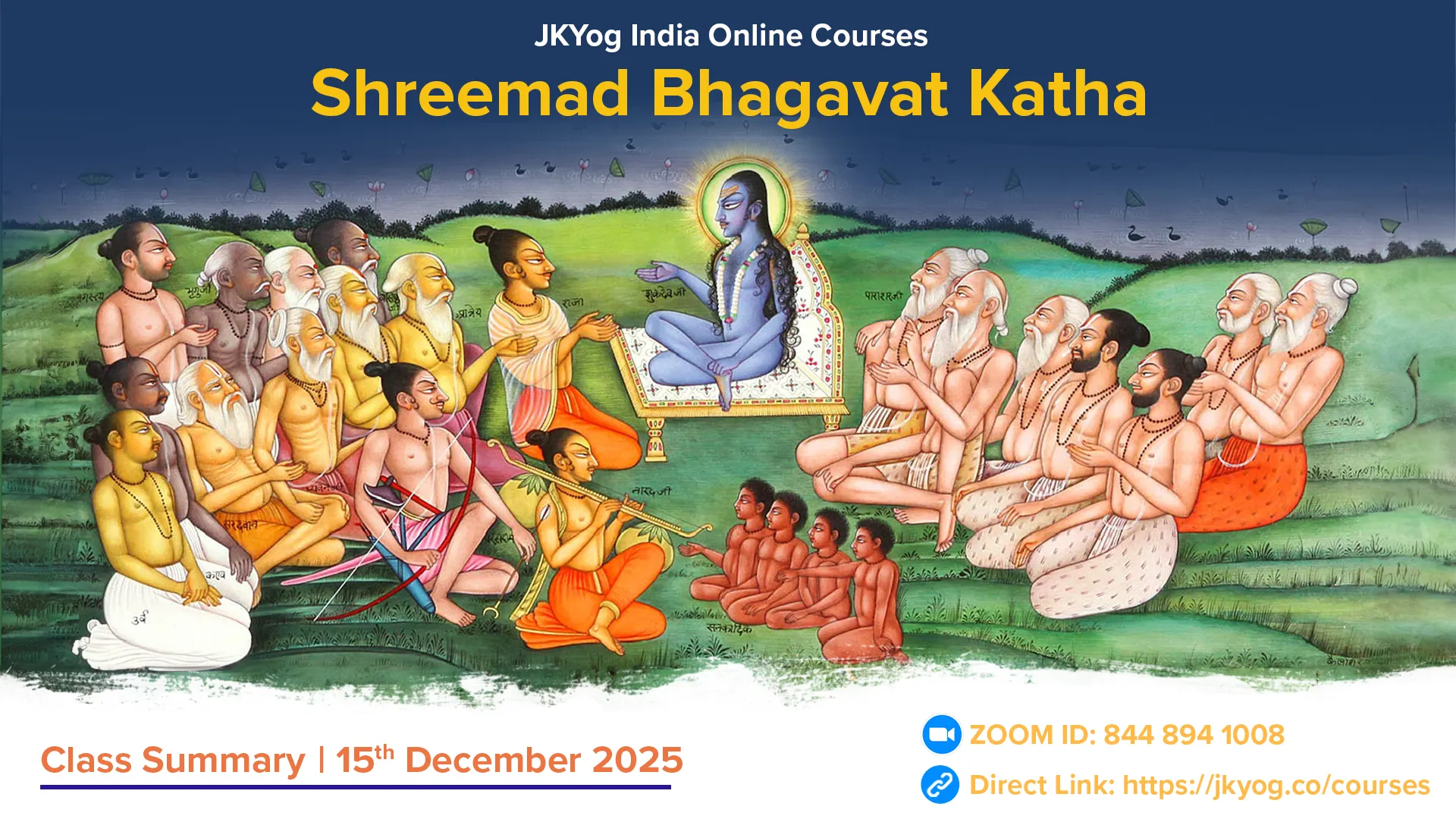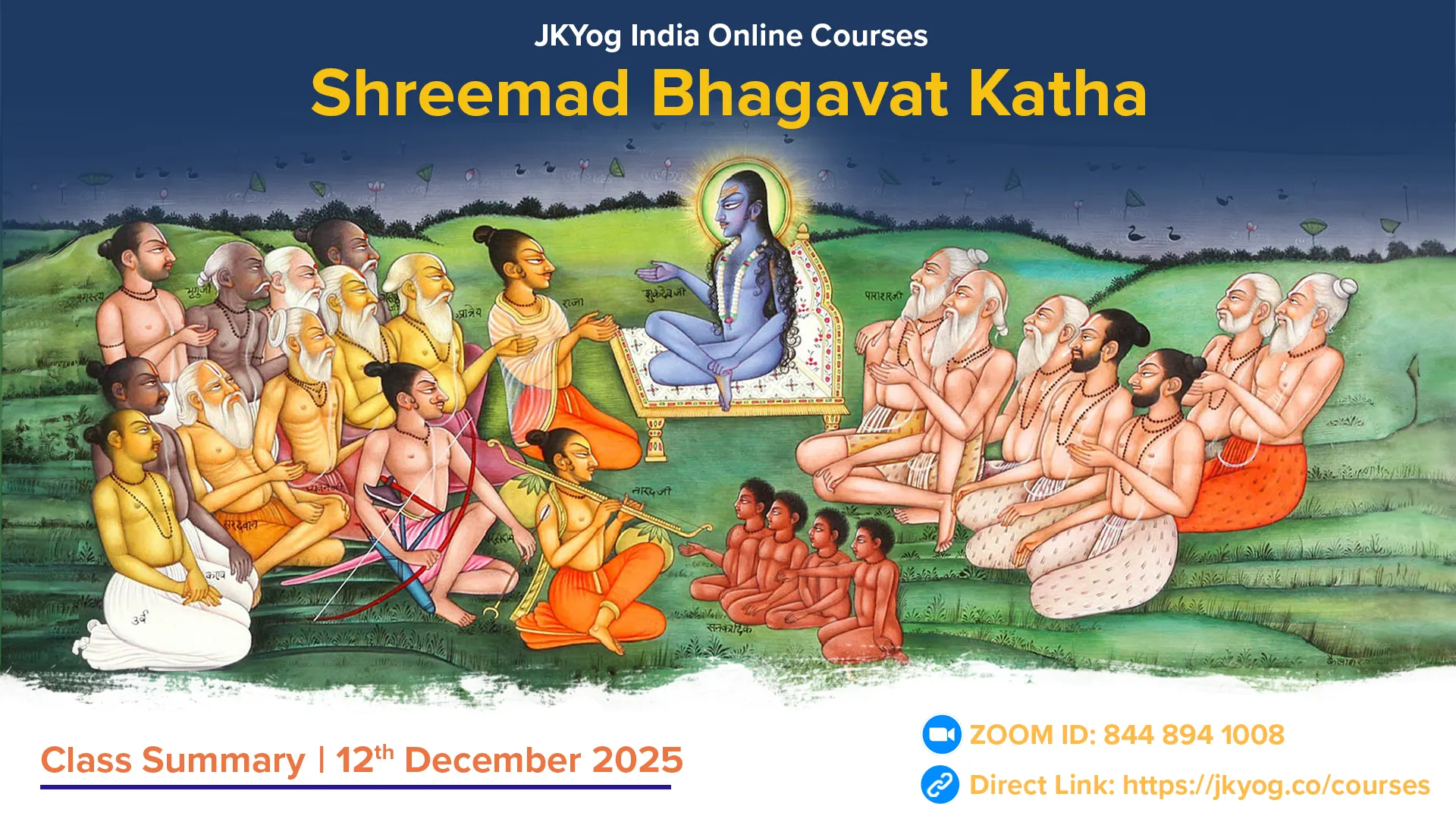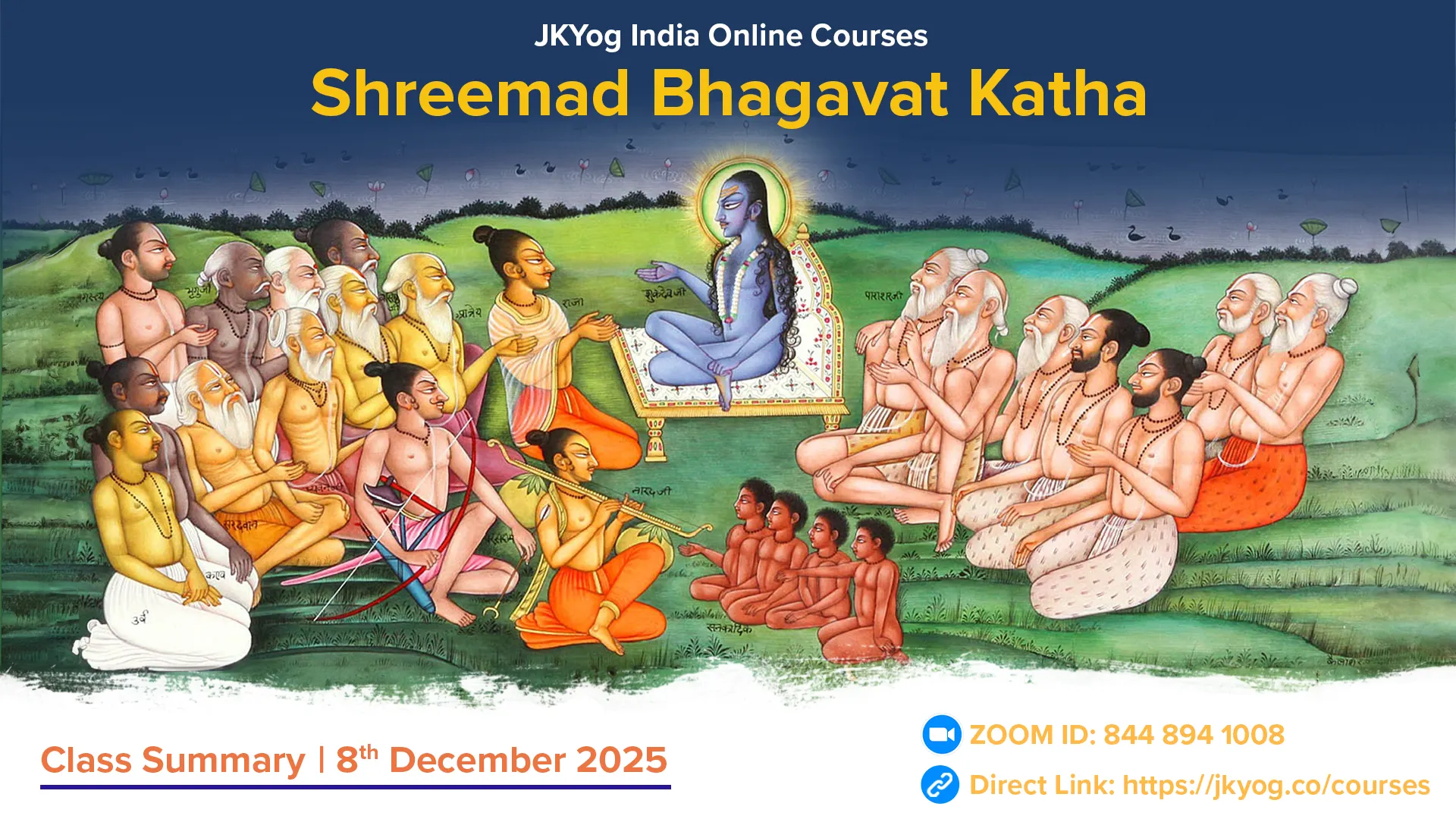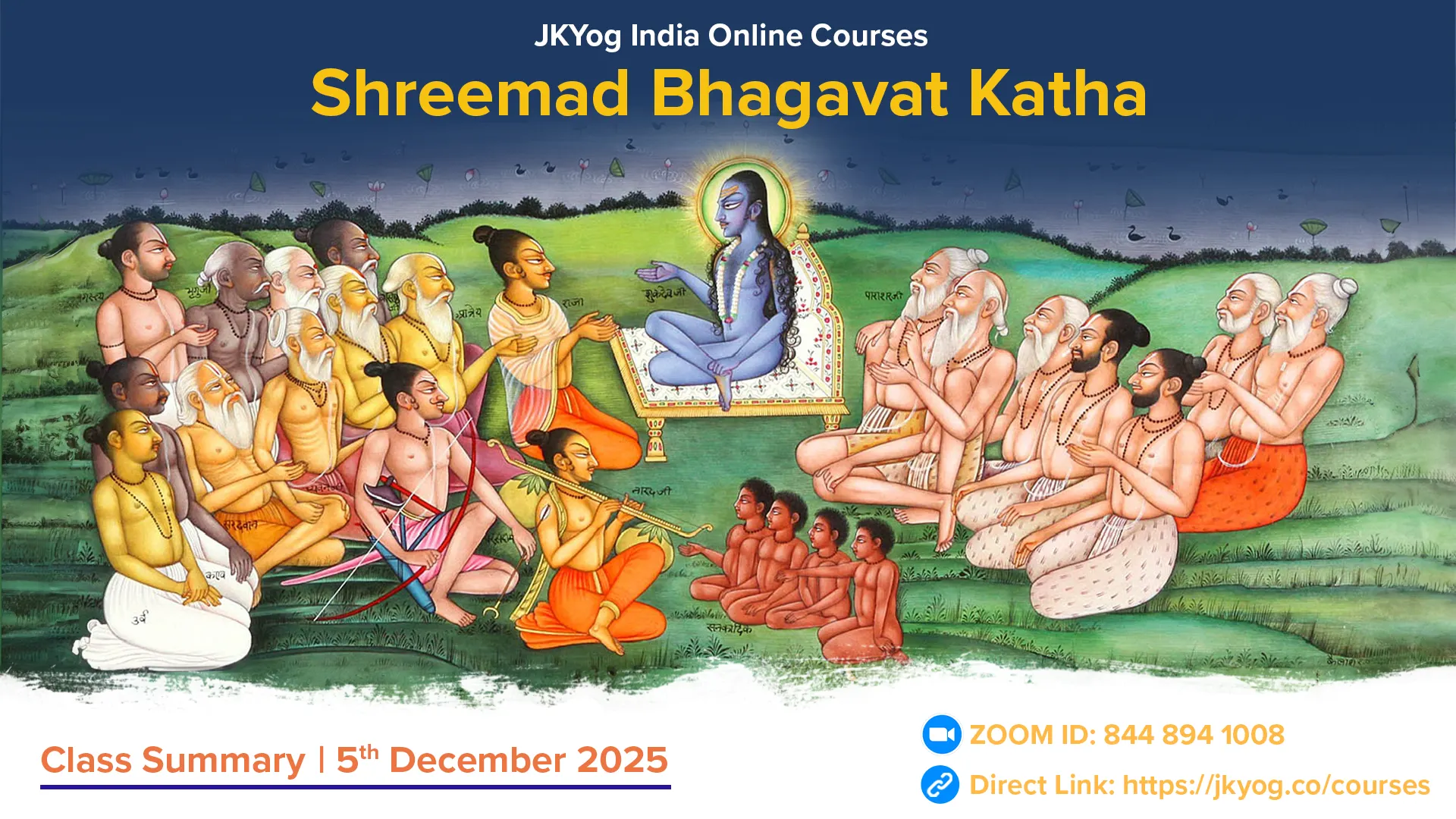Shreemad Bhagavat Mahapuran- Canto: 3, Chapters: 12 to 14
Maitreyaji tells Vidurji, "So far, I have narrated the glories of Bhagwan's form as Time. Now, listen to how Brahmaji created the universe. First, he created the five forms of ignorance—Tamas (ignorance), Moha (egoism), Mahamoha (attachment), Tamishra (envy), and Andhatamishra (fear of death). However, seeing this extremely sinful creation, he was not pleased. Then, purifying his mind through meditation on Bhagwan, he created another form of creation.
Sanakam cha Sanandam cha Sanatanam athatma-bhuh
Sanat-kumaram cha munin niskriyan urdhva-retasah
This time, Brahmaji created four celibate sages who are devoted to renunciation: Sanaka, Sananda, Sanatana, and Sanatkumar. (Bhagvat 3.12.4)
Brahmaji said to his sons, "Sons! You must create the universe." However, as they were naturally inclined towards the path of liberation and deeply immersed in meditation on Bhagwan, they did not wish to do so. When Brahmaji saw that his sons were not obeying his command and were disregarding him, he became unbearably angry. He tried to suppress this anger, but despite his efforts, that anger manifested instantly from between his eyebrows in the form of a blue-red-complexioned child.
Sa vai ruroda devanam purvajyo bhagavan bhavah
Namani kuru me dhatah sthanan cha jagad-guro
The ancestors of the gods, Bhagwan Bhava (Rudra), began to cry and say, "O Creator of the Universe! O Architect! Please tell me my name and my place of residence." (Bhagavat 3.12.8)
Hearing the child's plea, Brahmaji said, "Do not cry; I will fulfil your wish. Since you cried, people will know you by the name 'Rudra'." Then Brahmaji mentioned that places such as Hridaya (heart), Indriya (senses), Prana (life force), Akash (sky), Vayu (air), Agni (fire), Jala (water), Prithvi (earth), Surya (sun), Chandra (moon), and Tapas (austerities) had already been designated for him to reside.
Manyur Manur Mahinaso Mahan Shiva Ritadhvajah
Ugra-retah Bhavah Kaalo Vamadevo Dhritavratah
Your names will be Manyu, Manu, Mahinas, Mahan, Shiva, Ritadhvaja, Ugrareta, Bhava, Kala, Vamadeva, and Dhritavrata. (Bhagavat 3.12.12)
Dhir dhrutir asaloma cha niyut-sarpir ilambika
Iravati sudha diksha rudranyo rudra te striyah
Also, Dhi, Vritti, Ushna, Uma, Niyut, Sarpi, Ila, Ambika, Iravati, Sudha, and Diksha—these eleven Rudranis (goddesses) will be your wives. (Bhagavat 3.12.3)
Brahmaji instructed, "Accept the aforementioned names, places, and consorts, and create many beings, for you are the progenitor." Following Brahmaji's command, Bhagwan Rudra began to generate beings similar to Himself in strength, form, and nature. Seeing those Rudras created by Bhagwan Rudra forming countless hosts and consuming the entire world, Brahmaji became greatly concerned. He told Rudra that his progeny were destroying everything, so such a creation should not be made. Instead, Rudra should perform penance and later recreate the world. Following Brahmaji's instructions, Rudra went to the forest to undertake penance.
Subsequently, when Brahmaji, endowed with divine power, resolved to create the universe, ten sons were born to him. From them, the population of the worlds greatly increased.
Marichir Atri Angirasau Pulastyah Pulahah Kratuh
Bhrigur Vasishtho Dakshash cha dashamas tatra Naradah
Their names were Marichi, Atri, Angira, Pulastya, Pulaha, Kratu, Bhrigu, Vasistha, Daksha, and the tenth was Narada. (Bhagavat 3.12.22)
Naradji was born from the lap of Brahmaji, Daksha from his thumb, Vasistha from his life force, Bhrigu from his skin, Kratu from his hand, Pulaha from his navel, Pulastya Rishi from his ears, Angira from his mouth, Atri from his eyes, and Marichi from his mind. Then, from Brahmaji's right chest emerged Dharma, and from his back emerged Adharma, who led to the birth of Death, who terrified the world. Similarly, from Brahmaji's heart came Kaam (Desire), from his brows came Krodha (Anger), from his lower lip came Lobha (Greed), from his mouth came Saraswati, the deity of speech, from his organ came the ocean, from his anus came Nirṛti, and from his shadow came Kardamaji, the husband of Devahuti. In this manner, the entire universe was generated from Brahmaji's body and mind. Besides these, the Upaveda, Nyaya Shastra, Hota, Udgata, Adhvaryu, and Brahma—these four priests' functions, the expansion of Yajnas, the four stages of Dharma, and the four Ashrams and their activities—also originated from Brahmaji's mouths.
Upon Vidurji's inquiry, Maitreyaji explained that Brahmaji created the Rig, Yajur, Sama, and Atharva Vedas from his eastern, southern, western, and northern mouths, respectively. Similarly, the four Upavedas—Ayurveda (medical science), Dhanurveda (military science), Gandharvaveda (music), and Sthapatyaveda (architecture)—were also generated from these same directions. Brahmaji observed that despite the efforts of great and powerful Rishis like Marichi, the expansion of creation was insufficient. He began to contemplate that despite his continuous efforts, the growth of beings was not happening as expected, indicating some divine impediment.
While Brahmaji was reflecting on this divine issue, unexpectedly, his body split into two parts. From this split, a male-female pair emerged. The male was Svayambhuva Manu, and the female was his queen, Shatarupa. All human beings in the world are considered the progeny of Manu. The human body is called काय (Kāya) because 'क (Ka)' is one of Brahmaji's many names (ka iti brahmano nama). Since the body is made from 'क (Ka)', which refers to Brahmaji, it is called 'काय (Kāya)'. Humans are also called 'मनुष्य (Manuṣya)' and 'मानव (Manav)' because they are the progeny of 'मनु (Manu)'.
Since then, procreation began through the principles of duality. King Svayambhuva Manu had five children with Shatarupa: two sons, Priyavrata and Uttanapada, and three daughters, Akuti, Devahuti, and Prasuti. Manu married Akuti to Prajapati, Devahuti to Kardamaji, and Prasuti to Daksha Prajapati. Through these three daughters, the entire world was populated.
Shree Shukadevji told Parikshit that Vidurji then requested Maitreyaji to tell in detail what Manu and Shatrupa did after their creation. Maitreyji replied that when Manu was born with his wife Shatarupa, he humbly folded his hands and asked Brahmaji what action they should take to serve him. Brahmaji replied, "Produce virtuous progeny like yourself with your wife and sustain the earth in accordance with Dharma, and worship Shree Hari through Yajnas. This service of mine will be greatly honoured, and seeing you maintain the world, Bhagwan Shree Hari will also be pleased with you. Those who do not perform Yajna for the satisfaction of Janardana Bhagwan, all their efforts are considered as futile, as they essentially disrespect their own self."
Upon hearing Brahmaji's command, Manu said he would certainly follow the instruction but asked Brahmaji to specify a place for himself and his future progeny in this world, as the earth was currently submerged in the waters of dissolution. Brahmaji, contemplating how to rescue the earth, thought deeply about how to bring it back from the abyss of water where it had fallen while He was engaged in the creation of the world. He decided that only the all-powerful Shree Hari could accomplish this task.
Varah Avatar
As Brahmaji was thinking this, suddenly, a boar child (Varah) appeared from his nostrils. Initially, the child was the size of a thumb, but in an instant, He grew as large as an elephant. Varah Bhagwan roared, filling the directions with His sound. He then lifted the Earth from the water and set it down firmly after defeating Hiranyaksha, who had resisted Him. Brahmaji and the other sages extolled the glory of Varah Bhagwan, who assumed this form. His very body is the embodiment of the Yajna (sacrificial ritual), representing the sacrificial aspect itself, which is why He is called Yajnarupa. Varah Bhagwan then set the Earth on His tusks, lifted it from the water, and disappeared from sight.
Here, Viduraji questiones why Hiranyaksha fought with Varah Bhagwan while He was lifting the Earth from the water. Maitreyaji responded by explaining that Brahmaji had once recounted the story of the battle between Varah Bhagwan and Hiranyaksha to the gods, and now he is about to share this story with Viduraji.
The story begins with Diti, who prayed to her husband, Sage Kashyap, for offspring. Troubled by the influence of Kamadeva, she desired her husband's grace. Sage Kashyap explained that He would fulfil her wish, but she would need to wait a while as that time was considered the time of the spirits. He advised her to act with decency and wait peacefully. Diti, holding onto Sage Kashyap's clothes with great insistence, eventually got her wish fulfilled, and they united. Afterwards, Diti felt shame and prayed to Bhagwan Rudra for forgiveness and mercy.
Sage Kashyap informed Diti that due to her actions and the unfavourable time, two sons born from her womb would be extremely malevolent and troublesome. They would repeatedly torment all beings, including the devatas, Prajapati, etc. When their actions would lead to the slaughter of many innocent beings, atrocities against women, and distressing the righteous, the Supreme God would become enraged and descend to annihilate them. Sage Kashyap also mentioned that one of her two sons would have a son who would be honoured by devotees and saints. This child would be devoted to God, generous, and pure. His conduct and virtues would make him great, and he would be the one to end the world's suffering. Hearing that her grandson would be a devotee of the Shree Hari and that He would also slay her sons, Diti was very pleased and enthusiastic.
Summary: JKYog India Online Class- Shreemad Bhagavat Katha [Hindi]- 16.09.2024



